Exploring Codrington

Beez Neez now Chy Whella
Big Bear and Pepe Millard
Fri 15 May 2009 22:40
|
Codrington
After Foster dropped us at the jetty
and we had paid our Frigate Bird Fee we wandered into Codrington. First we
stopped in the Tourist Office and the ladies there allowed us to check our
emails - sadly Bear's Mum has been taken poorly and in hospital - "Get well soon
Mum".
   Main Street, an old
house and the Police Station.
The village of Codrington is a small,
sleepy town with a post office with telephone service, a supermarket, a bar, a
pharmacy and a couple of eateries. There is a brand new police station being
built and there are plenty of new builds amongst the old. Provisioning is basic
but we did see locals trotting down the street with Styrofoam boxes that
smelt delicious, we asked a chap where he had got his lunch and he directed us
to walk to the end of the road, turn right and find Marcie's on the left, we did
just that.
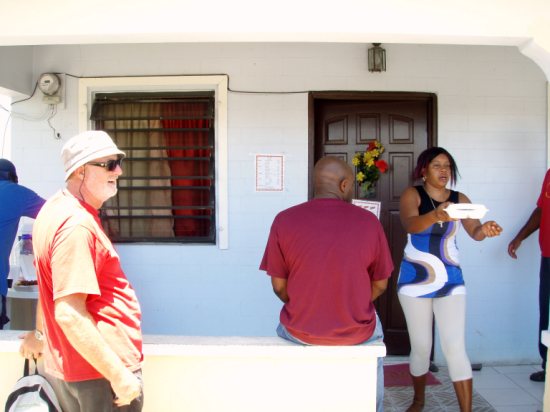 Marcie
handing over lunch to one of her customers and Bear in the queue.
Monday to Friday Marcia makes
food and sells it on her front porch. By the steady stream of customers
this is the place to buy lunch. On the front door was today's menu choice - Jerk
Chicken (sold out), Chicken Stew and Oxtail Stew served with scallop potato,
rice with kidney beans, coleslaw, salad and a choice of juice or soda for 20
EC$. I told Marcie it was Bear's birthday and she settled us in chairs on her
front porch and gave us some Jamaican over-proof rum to add to our juice. The
food was delicious. She sat with us between customers and made us very welcome.
We said we would need a taxi for a tour around the places of interest and she
kindly phoned Calvin who at the time was sitting eating his Marcia lunch.
(Marcia in some guide books - Marcie on her menu is from Jamaica). We finished
our feast and waited for Calvin.
   Martello Tower,
flag pole to the right of the picture, The view from
the tower and a baby donkey all fluffy.
First call was to Martello Tower near
the beach at River, three miles south of Codrington. The tower has a raised gun
platform and extremely thick walls, but is missing the floors. This type of
fortification was modeled on a tower built on Cape Martella. There was a fort on
the site before, probably built by the Spanish. Martello Tower of River Fort was
constructed some time during the first half of the eighteenth century, around
1745. It formed part of a battery of cannons that stretch from Coco Point in the
south-east to the canal on the western coast. In all seven battery of cannons
was part of the protective security system that prevented invasion by aggressive
foreign powers. These included the Spanish and French Naval
vessels.
The tower was also used as a signal
station to the inhabitants of Codrington. Flags were hoisted and signaled the
arrival of goods ships, if there was a vessel in distress, risk of
invasion or if a wreck was ready to be salvaged. The tower was built by
slaves, stands thirty two feet tall, constructed from local limestone, the
wood used on the lintels and other parts of the structure was imported from
Guiana. Much of the greenheart wood survives to this day. The fort once
protected the most accessible sea route into Barbuda, this explains why it is
such a robust structure surviving over two hundred and fifty years.
Just over Bear's shoulder is a
paw-paw tree in fruit and the tree in the middle photo is called a Sea Grape,
the fruit is collected by the islanders in November and a red wine is made to
drink over Christmas.
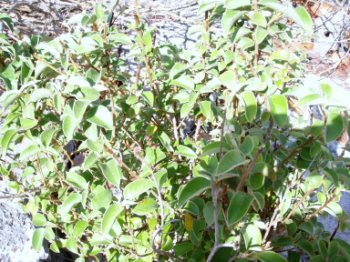 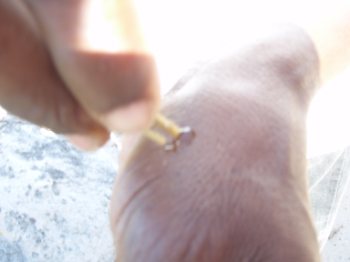  The Balsam
plant is natures band-aid. Break a small stem off, let some sap drip onto
to the affected area and rub until white, perfect, waterproof and
healing.
 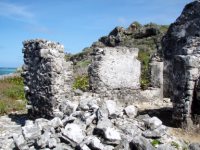  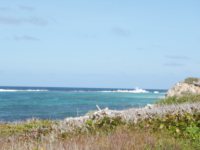  Two-Foot Bay House
was the lookout for the north-west coast. The sea area is
covered with reefs, inland looks to the Highlands, all 125 feet high. Here we
saw the logwood used to make the dye indigo.
   Bear disappearing
into Dark Cave and then on to Indian Cave. One of the petroglyphs.
   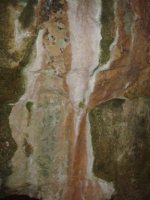 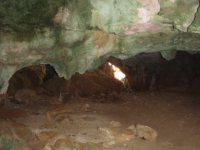 The colours
inside were amazing
Dark cave is the
Pleistocene limestone terrace of Barbuda. It is situated in the middle of the
north end of the highlands about four miles east of Codrington. After a rough
and rocky trail, teeming with hermit crabs, its low entrance is found at the
north side of a shallow sink hole, the bottom of which is covered with dry
scrub. Access to the cave is through a narrow slit you have to crawl through,
once inside there is a large cavern about four hundred feet long and about sixty
feet wide. There are water pools which probably were the water supply for the
inhabitants as artifacts have been found nearby. There is a rare sightless
shrimp and several rare species of crustacea found in the cave.
 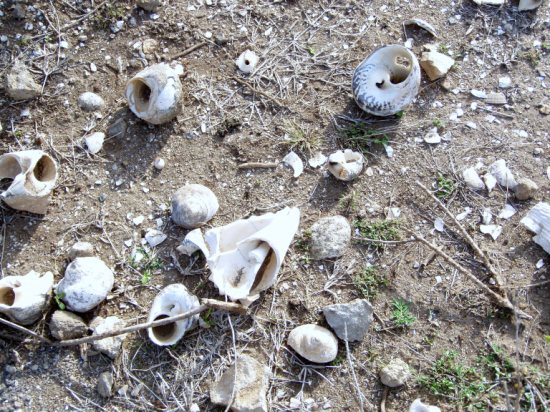 Conch shells,
fragments of pottery and delicately carved beads - a perfect hole through
the middle of which was made by putting a piece of sand at the end and drilling
it through on the end of a fine piece of wood. Recently a human skeleton was
found dating back to these times. As we wandered around Calvin pointed out
various plants, shrubs and trees and explained their uses, handed down through
the generations. Palmetto Palm, Coco Plum, Mutton Porridge Tree and the hardwood
Lingo Onet used for making spokes. The islanders have strong traditions from
their Indian and African heritage.
 The view from the
mouth of Indian cave through white cedar, cactus and scrub.
Indian cave is the
most interesting prehistoric site on Barbuda, a wild windswept part of the
north-east coast. The gentle climb to the small entrance is high up below the
top of the low cliff and well hidden by vegetation. Once inside you are
directly in a small round chamber of a lower level called Drop Cavern, one of a
series of caverns. Connected to Drop Cavern is Bat Chamber a conical shape about
thirty five feet high, bats do live in here but we didn't see any. From the main
entrance corridor there is a short narrow passage to the east in which two small
Amerindian rock carvings - petroglyphs - may be seen. The passage leads to yet
another cave flooded with light through the loose fitting ceiling, it was not
difficult to imagine this being a safe home, it is thought to have been the
dwelling place of a large number of Arawaks or Ciboney.
 Bear and Calvin walking toward the
ruins of "Willybob".
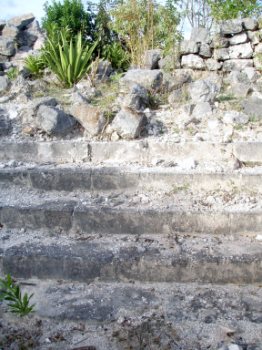 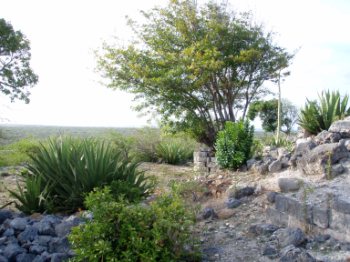  The main steps,
the view over the north of Barbuda and a "one careful owner" seat, set up by someone to enjoy the peace and the
vista.
Highland House, Codrington House or
now known to the locals as "Willybob" is about two and a half miles from
Codrington. It was originally built at the request of William Codrington, on a
high plateau overlooking the whole of the Estate. Construction started
around 1720 - according to a letter written at that time - and continued for
several years. The management of the construction was undertaken by Samuel
Martin and William Byam Esq. As part of the sub-lease arrangement. The compound
is highlighted on a map of Barbuda circulating during the 1750's. The period of
occupation has not been proven by historical records but archaeologists have
found types of china shards used at the site which indicate that the house was
occupied from about 1730 until the turn of the century. A bottle seal found
bears the name of Colonel John Gunthorpe; this indicates that the house my have
been occupied by William Byam who leased Barbuda from William Codrington from
1746 until his death in 1755. William Byam married Anne Gunthorpe the daughter
of the Colonel in 1735. The bottle of wine may have been a gift from his
father-in -law. It certainly connects Byam archaeologically with Highland
House.
A sample of timber used in the
construction of the house was taken and analysed in 1958, it was found to be
Bullet Wood - Manilkara Bidentata - probably common until the overcutting in the
19th century.
The site was used as a retreat
for the Codringtons whenever they were resident on the island. There was
accommodation for the manager and servants working in the highland area and also
a residence for special guests and visitors to the island. The site is currently
dilapidated but there are plans to sift through the rubble and "tidy it
up". The floors are remarkably intact as is the cistern and ablution
block.
 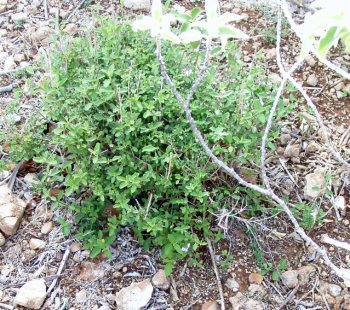 The Turpentine
tree, Sage of which this is one of five different species natural to
Barbuda, the locals use when they cook boar.
  School children at the end of the day
running in front of Government House and The
Ginnery.
Government House is located in the centre of Codrington
village behind the post office. The building dates from 1694 and by the gate has
a block for a rider to mount and dismount his horse. The building was lived in
by the wardens, who were the representatives of the British Government from the
time the Codrington left until 1976. Unfortunately the house was severely
damaged by hurricane Luis in 1995.
The Ginnery is one of the buildings used by the
Barbuda Council and was previously used as classrooms for the school. Salt and
cotton were stored here from the days of slavery until well into the 1900's. The
salt was still coated on the walls ten years ago, one can see dates and
quantities stenciled on the beams.
After a quick farewell to Calvin it
was off to the jetty to find Foster for our speedy lift back across the lagoon
and supper of jerk mince in tortilla wraps and salad, washed down with a glass
of wine.
ALL IN ALL A GREAT BIRTHDAY TREAT. An
interesting and packed day - a huge thank you to
Calvin.
|